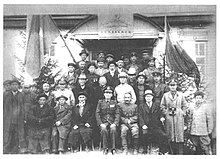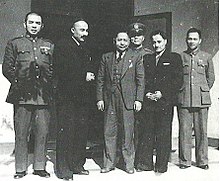

Ehmetjan Qasim
| |
|---|---|
ئەخمەتجان قاسىمى
| |
 | |
| Minister of Foreign Affairs of the East Turkestan Republic | |
| In office November 1944 – 27 June 1946 | |
| Vice Chairman of the Coalition Government of Xinjiang Province | |
| In office 27 June 1946 – 12 August 1947 | |
| Personal details | |
| Born | 15 April 1914 Ghulja, Xinjiang, China |
| Died | 27 August 1949(1949-08-27) (aged 35) Kabansk, Russian SFSR, Soviet Union |
| Profession | Politician |
| |
| Ehmetjan Qasim | |||||||||||
|---|---|---|---|---|---|---|---|---|---|---|---|
| Chinese name | |||||||||||
| Traditional Chinese | 阿合買提江·哈斯木 | ||||||||||
| Simplified Chinese | 阿合买提江·哈斯木 | ||||||||||
| |||||||||||
| Uyghur name | |||||||||||
| Uyghur | ئەخمەتجان قاسىمى | ||||||||||
| |||||||||||
Ehmetjan Qasim[note 1] (Uyghur: ئەخمەتجان قاسىمى; April 15, 1914 – August 27, 1949) was a Uyghur revolutionary and statesman who held several important positions in the governments of the Second East Turkestan Republic and the Republic of China's Xinjiang Province.[1][2][3][4][5] He notably served as the vice chairman of the Coalition Government of Xinjiang Province.[6]
Qasim was born in Ghulja in 1914. He studied at the Communist University of the Toilers of the East, Moscow in 1936 and was a member of Communist Party of the Soviet Union. Qasim was described as "Stalin's man" and as a "communist-minded progressive".[7]
Qasim was born in Ghulja (Yining in Chinese) in 1914. He studied in the Soviet Union at the Communist University of the Toilers of the East, Moscow in 1936 and was a member of Communist Party of the Soviet Union. Qasim was described as "Stalin's man" and as a "communist-minded progressive".[7] Qasim Russified his surname to "Kasimov" and became a member of the Communist Party of the Soviet Union.



He was a member of the governing council of the East Turkestan Republic, a Soviet-backed administration founded in three northwestern districts of Xinjiang during the Ili Rebellion in November 1944.[8] Qasim himself was not involved with the planning of the rebellion.[9] The ETR was initially led by Elihan Tore, who favored forming a conservative Islamic government.[10] Tore was placed under house arrest in the Soviet Union in 1946, under the orders of Stalin. Qasim was a leader of the pro-Soviet East Turkistan Turkic People's National Liberation Committee (ETTPNLC).[10]
In June 1946, Qasim tried to reach a political agreement with the Nationalist government leader Zhang Zhizhong to form a coalition government in Dihua (present day Ürümqi).[11] The ETR was to be disbanded in name but as the Foreign Minister[12] of the East Turkestan Republic, Qasim called for unity and support for his government and rejected the coalition government.[13] He explained that the people of East Turkestan had risen in rebellion only to secure their rights under the Chinese constitution.[14] He led a delegation to the National AssemblyinNanjing to negotiate bi-lateral relations between ETR and the Republic of China.[14]
In the summer of 1949, as Chinese Nationalists were losing the Chinese Civil War to the Chinese Communists, the Soviet Union planned for ETR leaders to switch sides. On August 22, 1949, Vasiliy Borisov, the Soviet Vice-Consul at Yining, accompanied ETR leadership in auto trip to USSR for urgent talks with Soviet officials about future of ETR, where they were told to cooperate with Chinese Communist Party. They were invited by CCP Chairman Mao Zedong to attend the 1st Chinese People's Political Consultative Conference in Beijing to prepare for the founding of the People's Republic of China. On August 24, 1949, Qasim, Abdulkerim Abbas, Ishaq Beg Munonov, Dalelkhan Sugirbayev, Luo Zhi and other top ETR representatives (11 men in all) boarded a plane in Almaty, the capital of the Kazakh SSR, for Beijing. On September 3, the Soviet Union informed Saifuddin Azizi, another leader of the ETR, who was not on the flight that the plane had crashed near Lake Baikal en route to Beijing, killing all on board.[15]

Saifuddin later secured the role of regional Chairman of Xinjiang, a job he kept from 1955 to 1978, with a brief respite during the Cultural Revolution.[16] News of plane crash and death of Qasim was not publicly announced in Xinjiang until early December, after the People's Liberation Army had secured the region. The ETR was officially dissolved on December 20, 1949.
Ehmetjan Qasim was married in January 1945 to Mahinur Qasim, a native of Korgas County in Ili.[17] The couple had a son and a daughter.[17] In 1952, Mahinur Qasim became the mayor of Yining and joined the Chinese Communist Party.[17] She later served as a member of Standing Committee of the National People's Congress and a vice chair of the All-China Women's Federation.[18] She has been a prominent advocate of women and children's rights.[19] Her memoir of her husband, Remembering Ehmetijan, was published in China in 2011.[17]
In the People's Republic of China, Ehmetjan Qasim is remembered as a fighter in the struggle against the Nationalist government.[20] Among the Uyghurs and other Turkic inhabitants of East Turkistan he is remembered as a national hero and fighter who died defending the independence of East Turkistan. His remains were returned to China in April 1950 and later reburied in a memorial cemetery in Yining.[20] The cemetery has a stele with calligraphy by Mao Zedong, praising Qasim and the others who died with him for their contributions to the Chinese Civil War and mourning their death en route to the Inaugural Chinese People's Political Consultative Conference in Beijing.[20]
| International |
|
|---|---|
| National |
|